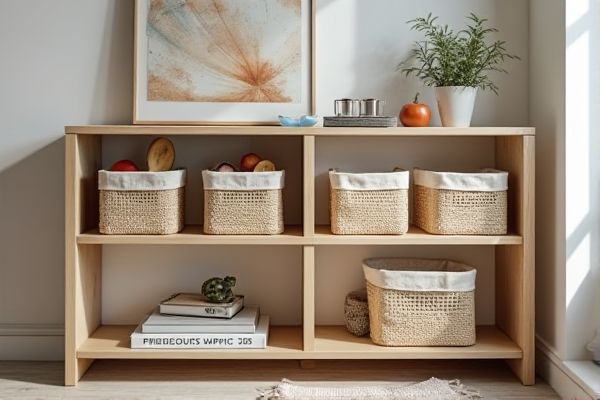
Shelf dividers create distinct vertical sections, helping you keep items neatly separated and easily accessible, while basket organizers group smaller items together for better containment and tidiness. Discover how choosing between a shelf divider and a basket organizer can transform Your storage solutions by reading the rest of the article.
Table of Comparison
| Feature | Shelf Divider | Basket Organizer |
|---|---|---|
| Purpose | Separates items on a shelf for better organization | Stores and organizes items within a basket |
| Material | Usually metal, wood, or plastic | Plastic, fabric, or metal mesh |
| Installation | Simple, often slides or clamps onto shelf | Placed inside baskets or drawers |
| Flexibility | Fixed or adjustable sizes available | Various sizes and compartments available |
| Best Use | Organizing books, files, clothes | Holding small items like toys, toiletries, kitchen utensils |
| Space Efficiency | Enhances vertical shelf space usage | Maximizes basket capacity by compartmentalizing |
| Price Range | Low to medium | Low to medium |
| Portability | Usually fixed in place | Highly portable and easy to move |
Understanding Shelf Dividers: What Are They?
Shelf dividers are vertical panels designed to separate and organize items on a shelf, preventing clutter and maximizing storage efficiency. Unlike basket organizers, which typically contain loose items within a bin, shelf dividers maintain visibility and access to individual items by creating distinct sections. You can use shelf dividers to keep books, files, or clothing neatly arranged, enhancing both functionality and aesthetics in your storage space.
Basket Organizers Explained: Features and Functions
Basket organizers offer versatile storage solutions designed to maximize space with sturdy handles and breathable materials, making them ideal for categorizing and containing items of various sizes. Unlike shelf dividers that segment horizontal surfaces, basket organizers provide flexible, removable compartments that adapt to your storage needs, enhancing accessibility and tidiness. Your pantry, closet, or office can benefit from the uniformity and portability that basket organizers uniquely deliver.
Key Differences Between Shelf Dividers and Basket Organizers
Shelf dividers create vertical separations to keep items upright and prevent clutter by segmenting existing shelf space, while basket organizers provide contained storage that can be moved or removed easily. You can use shelf dividers to maximize space on open shelves by maintaining order among books, plates, or towels, whereas basket organizers are ideal for grouping smaller or loose items like toys, accessories, or pantry goods. Understanding these key distinctions helps tailor your storage solutions to fit the type of items you want to organize and the flexibility you need.
Space Optimization: Which Organizer Works Best?
Shelf dividers maximize vertical space by creating separate sections, making them ideal for stacking items like plates, towels, or books without clutter. Basket organizers optimize horizontal and depth space by grouping smaller items together, preventing chaos and enhancing accessibility in drawers or cabinets. For tight shelves with stacked items, shelf dividers provide superior space optimization, whereas basket organizers excel in organizing loose, small objects efficiently.
Material Comparison: Shelf Dividers vs. Basket Organizers
Shelf dividers are typically made from durable materials like metal, wood, or acrylic, providing sturdy separation and long-lasting support for items on shelves. Basket organizers commonly use woven fibers, plastic, or wire, offering flexibility and breathability but sometimes less rigidity than dividers. Your choice depends on whether you need rigid, structured organization or a lightweight, adaptable option for storage.
Installation and Setup: Ease of Use Analysis
Shelf dividers typically require minimal installation, often sliding into existing shelves or snapping in place, making setup quick and tool-free for most models. Basket organizers may demand more effort during installation, including assembly and securing baskets to shelves or walls, which can involve screws or brackets. Users seeking the easiest and fastest setup should consider shelf dividers, as they usually offer straightforward, hassle-free installation compared to the more involved process of basket organizers.
Versatility in Storage: Different Use Cases
Shelf dividers excel in versatility by creating distinct vertical spaces ideal for organizing books, files, or dinnerware, preventing clutter and maximizing shelf capacity. Basket organizers offer flexible storage solutions for loose items such as toys, clothes, or pantry goods, making them perfect for dynamic environments like bedrooms or kitchens. Both tools optimize space efficiency but cater to unique organizational needs based on the type and accessibility of stored items.
Aesthetic Impact: Enhancing Your Space
Shelf dividers create a clean, minimalist look by clearly segmenting items on open shelves, enhancing visual order and sophistication. Basket organizers add texture and warmth with woven materials, contributing a cozy, rustic charm that softens the overall aesthetic. Choosing between the two depends on the desired style: modern and sleek with dividers or inviting and homely with baskets.
Cost Comparison and Value for Money
Shelf dividers generally cost less than basket organizers, making them a budget-friendly option for adding structure to storage spaces. Basket organizers, while pricier, often provide greater versatility and capacity for organizing a variety of items in closets and pantries. Evaluating value for money depends on the specific storage needs, with shelf dividers excelling in cost efficiency and basket organizers offering enhanced functionality.
Choosing the Right Organizer for Your Needs
Shelf dividers maximize vertical storage by separating items into neat sections, ideal for organizing clothes, linens, or pantry goods efficiently. Basket organizers provide flexible containment, perfect for corralling irregularly shaped items or bulkier belongings while maintaining easy access. Assess your storage space and item types to determine whether shelf dividers' structured segmentation or basket organizers' adaptable capacity better suits your needs.
 homyna.com
homyna.com